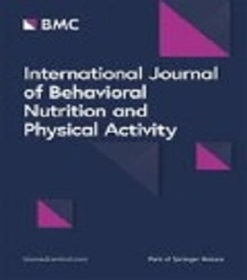西班牙普通人群中不同性别的慢性营养模式及其与体重的关系(GCAT 研究)
IF 5.6
1区 医学
Q1 NUTRITION & DIETETICS
International Journal of Behavioral Nutrition and Physical Activity
Pub Date : 2024-09-12
DOI:10.1186/s12966-024-01639-x
引用次数: 0
摘要
进餐时间模式的改变会扰乱昼夜节律系统并影响新陈代谢。我们的目的是描述特定性别的昼夜营养模式,评估其与体重指数(BMI)的关系,并研究睡眠在这种关系中的作用。我们利用西班牙加泰罗尼亚地区 40-65 岁成年人人群基因组生命(GCAT)(n = 7074)队列的 2018 年问卷数据进行横向分析,并利用其 2023 年的后续问卷数据(n = 3128)进行纵向分析。我们进行了多变量线性回归,以探讨相互调整的进餐时间变量(第一餐时间、进餐次数、夜间禁食时间)与体重指数之间的关系,同时考虑到睡眠时间和质量以及其他相关混杂因素,包括是否坚持地中海饮食。最后,我们分别对男性和女性进行了聚类分析,以确定慢性营养模式,并比较了不同聚类的社会人口学特征和生活方式特征,分析了它们与体重指数的关系。在横断面分析中,第一餐时间较晚(β 1 小时增加=0.32,95% CI 0.18,0.47)和进食次数较多(仅女性,β 1 次进食次数增加=0.25,95% CI 0.00,0.51)与较高的体重指数相关,而夜间禁食时间较长与较低的体重指数相关(β 1 小时增加=-0.27,95% CI -0.41,-0.13)。这些关联在绝经前妇女中尤为明显。纵向分析证实了与第一餐时间和夜间空腹时间的关系,尤其是男性。最后,我们得出了 3 个性别特异性聚类,这些聚类在进食次数和第一餐进食时间上存在很大差异。第一餐进食时间较晚的群组中,男性受教育程度较低,失业率较高,男女的体重指数均较高。只有在男性的最小群组中发现了明显的 "不吃早餐 "模式。在以人口为基础的加泰罗尼亚成年人队列中,我们发现,无论是在横截面分析还是纵向分析中,第一餐进食时间较晚与较高的体重指数有关,而夜间空腹时间较长与较低的体重指数有关。本文章由计算机程序翻译,如有差异,请以英文原文为准。
Sex-specific chrono-nutritional patterns and association with body weight in a general population in Spain (GCAT study)
Altered meal timing patterns can disrupt the circadian system and affect metabolism. Our aim was to describe sex-specific chrono-nutritional patterns, assess their association with body mass index (BMI) and investigate the role of sleep in this relationship. We used the 2018 questionnaire data from the population-based Genomes for Life (GCAT) (n = 7074) cohort of adults aged 40–65 in Catalonia, Spain, for cross-sectional analysis and its follow-up questionnaire data in 2023 (n = 3128) for longitudinal analysis. We conducted multivariate linear regressions to explore the association between mutually adjusted meal-timing variables (time of first meal, number of eating occasions, nighttime fasting duration) and BMI, accounting for sleep duration and quality, and additional relevant confounders including adherence to a Mediterranean diet. Finally, cluster analysis was performed to identify chrono-nutritional patterns, separately for men and women, and sociodemographic and lifestyle characteristics were compared across clusters and analyzed for associations with BMI. In the cross-sectional analysis, a later time of first meal (β 1 h increase = 0.32, 95% CI 0.18, 0.47) and more eating occasions (only in women, β 1 more eating occasion = 0.25, 95% CI 0.00, 0.51) were associated with a higher BMI, while longer nighttime fasting duration with a lower BMI (β 1 h increase=-0.27, 95% CI -0.41, -0.13). These associations were particularly evident in premenopausal women. Longitudinal analyses corroborated the associations with time of first meal and nighttime fasting duration, particularly in men. Finally, we obtained 3 sex-specific clusters, that mostly differed in number of eating occasions and time of first meal. Clusters defined by a late first meal displayed lower education and higher unemployment in men, as well as higher BMI for both sexes. A clear “breakfast skipping” pattern was identified only in the smallest cluster in men. In a population-based cohort of adults in Catalonia, we found that a later time of first meal was associated with higher BMI, while longer nighttime fasting duration associated with a lower BMI, both in cross-sectional and longitudinal analyses.
求助全文
通过发布文献求助,成功后即可免费获取论文全文。
去求助
来源期刊
CiteScore
13.80
自引率
3.40%
发文量
138
审稿时长
4-8 weeks
期刊介绍:
International Journal of Behavioral Nutrition and Physical Activity (IJBNPA) is an open access, peer-reviewed journal offering high quality articles, rapid publication and wide diffusion in the public domain.
IJBNPA is devoted to furthering the understanding of the behavioral aspects of diet and physical activity and is unique in its inclusion of multiple levels of analysis, including populations, groups and individuals and its inclusion of epidemiology, and behavioral, theoretical and measurement research areas.

 求助内容:
求助内容: 应助结果提醒方式:
应助结果提醒方式:


